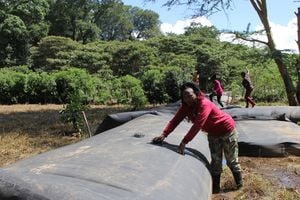Our laws have come this far, but are they serving girls?

International Day of the Girl Child is celebrated on 11th of October annually
What you need to know:
- It is 28 years after the Beijing Declaration and Platform for Action on Gender Equality in Kenya
- Statistics indicate that only 20 percent of girls aged 15-19 tend to complete secondary education and fewer transition into tertiary learning
It is 28 years after the Beijing Declaration and Platform for Action on Gender Equality in Kenya, just as is in Afghanistan and many other parts of the world.
This journey that most women and girls continue to travel has come with a progressive Constitution, hosting a powerful and empowering Bill of Rights within a society struggling with existing and emerging gender discourses upon the difficulty of liberating self from extreme patriarchal attitudes and communication.
The spaces to engage and grow have been expanded, yet the number of girls and women in strategic sectors needs to be more served.
Article 27 of the Constitution places a burden on the Kenyan society and leadership to address the issue of equality. Clause 1 of this Article provides every person's right to equality before the law and the benefit that accrues from it.
Clause 2 further provides the right to fully and equally enjoy fundamental rights and freedoms. While 3 entrenches the right to equal treatment, including political, economic, cultural, and social opportunities.
Article 43 (1-f), of the Constitution, if seen and read through the text of the Education Act, points to the legal demand of ensuring education is for all children. Section 3 (1) requires the Cabinet Secretary to promote the education of the people and the progressive development of institutions devoted to promoting education.
However, statistics indicate that only 20 percent of girls aged 15-19 tend to complete secondary education, and fewer transition into tertiary learning.
Access to Information Act of 2016 gives every citizen, including girls and women, the right to access information held by the state, another person, or an institution required to exercise or protect any right or fundamental freedom. The thrust of this right is constitutional in Article 35.
Weighing it against scientific revelations and facts, it is surprising that only 50% of girls freely discuss menstrual health matters in their homes.
In addition, and sadly, only 12% willingly and comfortably receive information about their menstrual health. Yet institutionally, 68% of rural schools do not possess some form of privacy where girls can change their sanitary pads.
These circumstances belittle Article 43 (1a) provisions, which gives every person the right to the highest standard of health, including the right to reproductive health care.
Article 53(2) of the Constitution demands that every person, institution, and society always make decisions, design programs, allocate budgets, provide financing, and every other necessary action in children's best interest where circumstances and issues touch them.
In this context, several laws have been enacted in the spirit of the United Nations Convention on the Rights of Children, the Maputo Protocol on Women's Rights and Sustainable Development Goals, which emphasize the tenets anchored on ‘Leave No One Behind.’
The Children's Act of 2022 provides every child with room for unqualified access to survival rights, protection, participation, and development. It has cut through the innuendos of boy and girl child preferences, common but less publicly spoken about amongst parents.
While the law creates environments that radiate equality, it also allows for and recognises equity to prevail. Girls, without sounding prejudicial and stereotypic, tend to face more challenges.
Laws such as the Prohibition of Female Genital Mutilation Act of 2011 specifically respond to avert the cut's catastrophe.
The Sexual Offenses Act of 2006, whose spirit and application touches both male and female children and adults, was highly motivated by the unique sexual-related suffering, violations, and abuses that female children and adults faced.
It is documented that 11% of girls, compared to 4% of boys, experience sexual violence before their 18th birthday.
Many other laws have tried to reduce societal blindness to the plight of women, often couched in cultural trappings of masculinity or patriarchy.
The Victim Protection Act of 2014 and the Protection of Domestic Violence Act of 2015 underscore the rights of a survivor, especially those of gender-based violence. It comes from a victim-rich mentality and drives the rights of survivors.
The two Acts regarding matrimonial property and marriage, the latter enacted in 2014 and the former in 2013, also speak to the rights of women, in particular those defined in Articles 40 and 45 of the Constitution.
As the country celebrates the International Day of the Girl Child today, let us applaud the purpose, alongside what Michelle Obama, in her book Becoming, stated, "...women endure entire lifetimes of these indignities—in the form of catcalls, groping, assault, oppression.
These things injure us. They sap our strength. Some of the cuts are so small they're barely visible. Others are huge and gaping, leaving scars that never heal. Either way, they accumulate. We carry them everywhere: to and from school and work, at home, while raising our children, at our places of worship, anytime we try to advance.”
Send your legal questions to [email protected]





